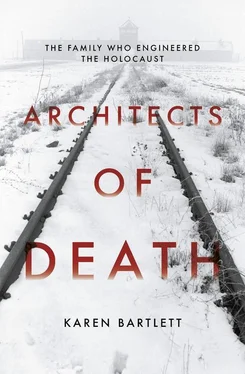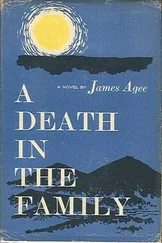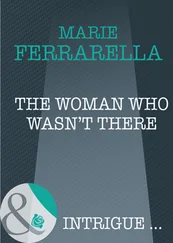Max Machemehl was born in 1891 in Erfurt and, like Kurt Prüfer, had served in the First World War (though not on the Western Front). After leaving junior school, Machemehl joined Topf and Sons, where he would continue to work for the rest of his career, and was promoted to authorised representative in 1935. Like Prüfer, Machemehl was married without children. Also like Prüfer, Machemehl joined the Nazi Party at the end of April 1933. Both Prüfer and Machemehl held Nazi positions within the company during the Third Reich. Prüfer represented the German Labour Front within the company; Machemehl reported to the Security Services and the Gestapo on the mood and activities inside Topf and Sons. Gustav Braun reported that in 1944 Machemehl had approached him twice wanting to discuss production and the mood among the workers. When Braun questioned him, Machemehl produced a letter from the head of the Erfurt Gestapo, Reinhard Wolff, stating that Machemehl was required to submit reports about the situation at Topf and Sons. Wolff later explained that the Gestapo had spies inside every Erfurt factory – at Topf and Sons it was Max Machemehl.
The SS were late in paying more than half of their invoices, and in some cases they would delay payments by more than a year. In those instances, it was up to Max Machemehl to pen repeated reminders. On 2 July 1943, he wrote this letter in relation to late payment for the lifts at Crematoria II and III at Auschwitz, the fumigator for the ‘sauna’ and the waste incinerator: ‘We hereby take the liberty of again sending you a list of the sums that still remain open on your account, from which you will see that the amount owing to us at this time comes to 32,732 RM. We have already written to you repeatedly about these outstanding sums on 16 April, 25 May, and 11 June 1943…’
Machemehl continues that he has been informed by Kurt Prüfer that these invoices have already been authorised and passed on to Berlin for payment. ‘Since we are dependent on our accounts receivable, and the sums have now been overdue for some considerable time, despite our repeated requests for payment, we hope it will not be necessary to contact you again concerning this matter.’ [103] Schüle, op. cit., p. 230. AS footnote 265: Topf to the SS Construction Management Dept, Auschwitz, 2 July 1943, ThHStAW, Collection Jean-Claude Pressac Nr. 42, sheet 388; also Buchenwald Memorial Archive, Pressac Collection, sheet 1053.
This letter had little effect apparently: the SS paid part of the invoices two months later, and the remaining part only in the summer of 1944.
Despite his involvement in all of Topf and Sons’ deals with the SS, Machemehl insisted that his work at the concentration camps involved ‘perfectly ordinary business’ deals, and he moved seamlessly to forge a new career after the war in communist-controlled East Germany. His slipperiness is alluded to in a staff poem from the sixtieth anniversary commemorative booklet published in 1938:
There, where the wax floor makes things slippy,
On the first floor, sits Mache-Max
Neatly behind glass and frame
With his slim ladies…
The door is never still here
The telephone rings constantly
This is where all the money decisions are made. [104] Topf and Sons sixtieth anniversary commemorative booklet, Landesarchiv Thüringen -Hauptstaatsarchiv Weimar.
Of course, Topf and Sons never made more than 2 per cent of its earnings from Kurt Prüfer’s work with the concentration camps. At its peak in 1943, the annual earnings from Auschwitz never went above 1.85 per cent. Translated into today’s money, Topf and Sons made only €30,600 per year in profit from developing the technology of the Holocaust.
The company had sold its soul for such little financial gain, hastening, in the case of Auschwitz, nearly 1 million people to their deaths in the gas chambers.
A large number of these people were murdered in the summer of 1944, when the arrival of Hungarian Jews pushed Topf technology to the limits. An agreement between the German-allied government of the Hungarian chief of state, Regent Miklós Horthy, and the Third Reich had kept Hungarian Jews just beyond Hitler’s reach, until the German occupation of Hungary in March 1944.
The Hungarian government was itself one of the most anti-Semitic in Europe, and had passed hundreds of anti-Jewish laws in the 1930s. In November 1940, Hungarian Prime Minister Pál Teleki had advocated to Hitler that all Jews should be expelled from Europe, and the Hungarian government had murdered Jews on several occasions before the German occupation. In the summer of 1941, 18,000 Jews were deported to German-occupied Ukraine, with full knowledge that only death awaited them, and in January 1942, a further 1,000 Jews were murdered by the Hungarian military in Újvidék.
Despite this, the remaining presence of nearly 800,000 Jews in Hungary loomed large in Hitler’s mind, and the German invasion of 1944, which aimed to keep Hungary loyal to the Third Reich by force, was followed by a Sonderkommando unit headed by Adolf Eichmann who was charged with implementing the Final Solution in Hungary. New anti-Jewish decrees were quickly passed: Hungarian Jews were forced to wear the yellow star, Jewish businesses and properties were seized, and Jews were forced into ghettos. These ghettos, however, were short-lived ones, and between 15 May and 9 July 430,000 Hungarian Jews were deported – mostly to Auschwitz.
More Hungarian Jews were murdered in those two shorts months at Birkenau than in the previous two years. An average of 3,300 people were transported every day, rising to 4,300 on some days – and three quarters of those people were sent straight to the gas chambers. Eva Schloss, who arrived from the Netherlands that same summer remembered: ‘The flames from the crematoria burned brightly, night after night, and all night long, but now everyone was dead – and we had sorted out the belongings that they had been forced to leave behind.’ [105] Schloss and Bartlett, op. cit., p. 130.
In total, nearly 440,000 Hungarian Jews were sent to Auschwitz, and on some days as many as 10,000 bodies were burned in either Crematoria II, III and IV or in open-air pits. These people were murdered and incinerated using the technology that Topf and Sons were so proud of developing.
Their clients and partners, the SS, were also pleased with the advances they had overseen in the more efficient murder of millions. Upon completion of the new extermination facilities, SS officer Perry Broad recalled that the SS had organised a photo exhibition of the new crematoria to be displayed in the entrance hall of the main building at Auschwitz. ‘They forgot that when civilians were coming and going and they saw a large picture of the fifteen neatly set-out crematorium ovens, their reaction would be less likely to be admiration for the construction manager’s technical skills than horror at the extremely dubious installations of the Third Reich.’ [106] Schüle, op. cit., pp. 192–6. AS footnote 145: Karl/Noack, Angeklagter [PK:Accused], p. 67f.
CHAPTER NINE
TRIALS AND RETRIBUTION
With the Soviet forces closing in, the SS at Auschwitz realised that the end was near. In those final months they had murdered with a frenzy, sifting out those who could be sent on the ‘death marches’ back to Germany where they would be labourers, and dispatching those who remained: the young, the sick and the elderly. In just two weeks in October 1944, roughly 40,000 people were killed in the Birkenau gas chambers.
Then the gassing and burning of Auschwitz-Birkenau was over. On 25 November 1944, work started on dismantling Crematorium II and Crematorium III, but the Third Reich, aided by Topf and Sons, had still not given up on its dream of the total eradication of all Jews and prisoners. A member of the special unit notes that the following day, on 26 November:
Читать дальше












